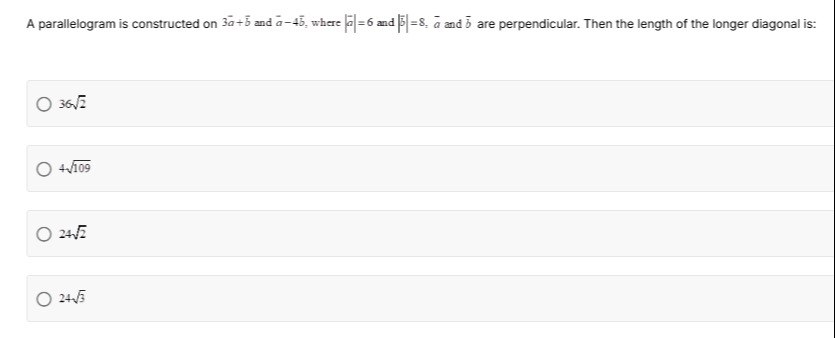Question
Question: A parallelogram is constructed on $3\overline{a}+\overline{b}$ and $\overline{a}-4\overline{b}$, whe...
A parallelogram is constructed on 3a+b and a−4b, where ∣a∣=6 and ∣b∣=8, a and b are perpendicular. Then the length of the longer diagonal is:

36\sqrt{2}
4\sqrt{109}
24\sqrt{2}
24\sqrt{3}
4\sqrt{109}
Solution
Let the two vectors forming the adjacent sides of the parallelogram be p=3a+b and q=a−4b. The diagonals of the parallelogram are given by d1=p+q and d2=p−q.
First, find the vectors representing the diagonals: d1=(3a+b)+(a−4b)=4a−3b d2=(3a+b)−(a−4b)=3a+b−a+4b=2a+5b
We are given that ∣a∣=6, ∣b∣=8, and a and b are perpendicular. This means a⋅b=0.
The square of the magnitude of a vector of the form c1a+c2b is given by: ∣c1a+c2b∣2=(c1a+c2b)⋅(c1a+c2b) =c12∣a∣2+c22∣b∣2+2c1c2(a⋅b) Since a⋅b=0, this simplifies to: ∣c1a+c2b∣2=c12∣a∣2+c22∣b∣2
Now, calculate the square of the magnitudes of the diagonals:
For d1=4a−3b: ∣d1∣2=(4)2∣a∣2+(−3)2∣b∣2 ∣d1∣2=16∣a∣2+9∣b∣2 Substitute the given values ∣a∣=6 and ∣b∣=8: ∣d1∣2=16(62)+9(82)=16(36)+9(64)=576+576=1152 ∣d1∣=1152=576×2=242
For d2=2a+5b: ∣d2∣2=(2)2∣a∣2+(5)2∣b∣2 ∣d2∣2=4∣a∣2+25∣b∣2 Substitute the given values ∣a∣=6 and ∣b∣=8: ∣d2∣2=4(62)+25(82)=4(36)+25(64)=144+1600=1744 ∣d2∣=1744=16×109=4109
To find the longer diagonal, we compare the squares of their lengths: ∣d1∣2=1152 ∣d2∣2=1744 Since 1744>1152, the diagonal d2 is longer.
The length of the longer diagonal is 4109.
